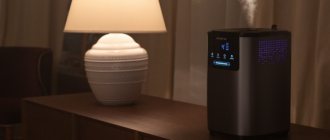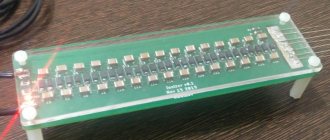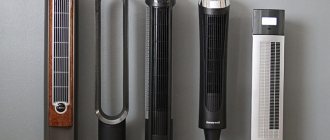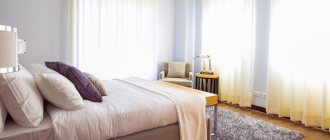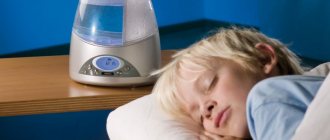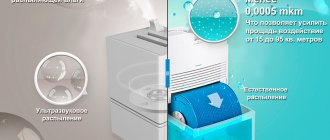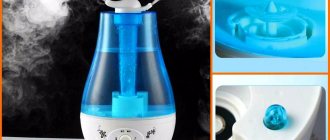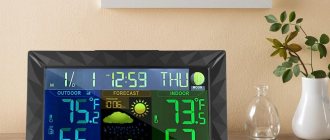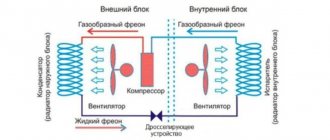Why do you need a humidifier?
With the onset of cold weather, when the central heating is turned on, the air in the rooms becomes dry, deprived of the necessary moisture. In most Russian regions, the heating season lasts up to six months. Radiators and heaters practically dry out the air in the room. Additional heating in the off-season ensures high moisture loss.
In order not to harm the human body, the air in the room must have certain characteristics.
The required parameters are as follows:
- normal temperature varies from 19 to 250C;
- optimal humidity – 40-60%;
- oxygen saturation level is approximately 26%.
A complete absence of toxic substances, pathogenic bacteria, viruses, and household dust is also required. Dry air affects the mucous membranes. The eyes and respiratory tract are affected first. The skin becomes dry. Low humidity is the cause of accelerated skin aging. It becomes denser, dries out and flakes off. The skin loses its protective functions. This causes various skin diseases, and especially pustular lesions.
Low air humidity provokes a decrease in immunity. Drying the mucous membranes increases the permeability of physiological barriers to the penetration of viruses and bacteria. The likelihood of developing acute respiratory diseases increases.
Dry indoor conditions result in the following diseases:
- flu;
- ARVI;
- tracheitis;
- sinusitis;
- bronchitis;
- rhinitis;
- tonsillitis;
- pneumonia;
- proliferation of adenoid tissue.
Pathogenic agents multiply more actively on the dried mucosa of the upper respiratory tract. The epithelium loses cilia. It does not evacuate harmful particles from the bronchi and lungs. Bacteria and viruses settle, then accumulate in the bronchi and lung tissue.
But the harm of dry air does not end there. Under these conditions, all allergens constantly fly upward. Fine house dust constantly enters the human body. Irritation of the nasal mucosa, eyes and often exacerbating diseases of the upper respiratory tract provoke the development of bronchial asthma and other pathologies caused by allergic reactions.
A large number of artificial materials are used in our homes. They constantly release toxic substances and pollute the air. These volatile compounds spread easily in dry air and quickly penetrate the blood-brain barrier. They have a toxic effect on nerve cells. They provoke inflammatory reactions of an autoimmune nature.
Dry air causes a deterioration in a person’s general condition and well-being. This provokes nausea, dizziness, drowsiness and increased fatigue. These symptoms appear due to impaired oxygen transport. Under such conditions, its attachment to hemoglobin and delivery to tissues deteriorates. The neurons in the brain are the first to suffer.
Nowadays people are well aware of the dangers of dry air. Humidifiers have become ubiquitous. Almost everyone has it, and has ceased to be something unusual. The device optimizes air humidity, significantly improving the well-being of apartment residents. It prevents serious illnesses in children and adults. These climate control devices, designed to humidify the air, are necessary in any home.
The benefits and harms of a humidifier
Pros:
- Improving the condition of the skin. If the skin is peeling, itching, cracking, then it definitely lacks moisture. This leads to premature aging of the tissue. To solve the problem, along with microclimate regulation, use additional products in the form of ointments, creams and gels.
- Protection against bacteria and viruses, helping the immune system. The fact is that overdried mucous membranes of the nasopharynx lose their protective powers, which can lead to the rapid development of a minor infection. It is no wonder that the peak of infectious diseases is recorded precisely in the winter period.
- Reduced fatigue. The tone of the body directly depends on sufficient oxygen saturation of the blood. Inhaling a moistened air mass helps improve its delivery to all organs, preserve and increase energy reserves. This is especially noticeable among older people.
- Benefits for the eyes. The point is simple: insufficient hydration leads to overexertion and rapid fatigue.
- Quality sleep. This is especially true for children. The humidity level in them should be at least 50%. If this condition is met and regular airing is done, children will have a more restful sleep and get sick less often.
- Increased attention and concentration. This is due to the previously mentioned oxygen, the lack of which in dry air reduces the cognitive abilities of the brain.
Minuses:
- The need for periodic cleaning. Because Since we are dealing with water, it is difficult to completely avoid lime deposits on work surfaces. How to descale a humidifier is usually written in the instructions from the manufacturer; this information can also be easily found on the Internet.
- Excessive humidity. Let’s say right away that achieving this is extremely difficult; the stars literally have to align here. However, this cannot be completely ruled out. Too humid air promotes the formation of fungi, mold and swelling of furniture. If you want to clearly monitor humidity levels, purchase devices with a built-in hygrometer.
- When using humidifiers from some manufacturers, you may encounter dust or white residue settling on the furniture. Carefully read the reviews of each model before purchasing on different sites to avoid this disadvantage if possible.
- If you do not control the operation of the humidifier or set settings different from those recommended by the manufacturer, you can catch a cold. You can get sick from a humidifier if the humidity in the room is constantly above 60% - in this case, mucus can accumulate in the lungs. In general, the humidifier is not dangerous if used correctly - follow the recommendations from the manufacturer's instructions for use to avoid harmful consequences.
Types of humidifiers, their pros and cons
Air humidifiers used in everyday life are divided into several categories. All these modern devices are easy to use and do not require special installation. They are able to humidify the air in a closed room around the clock. Modern technologies provide low noise levels. They do not irritate or distract the inhabitants of the home from business. They are based on different operating principles: ultrasound, natural humidification, steam generation.
☑ “Cold” humidifier
In these devices, air passes through a humidifying cartridge. The use of a fan in the design speeds up its circulation. Water is poured into a special tank of the device. From there it goes to a special evaporation element. To operate “Cold” humidifiers, it is advisable to use only demineralized or distilled water. If this rule is not followed, the humidifying unit will become clogged.
It will have to be changed quickly. This type of device is suitable for offices and apartments. They are allowed to be used in children's rooms. They are suitable for aromatherapy. Their advantages are considered to be: economical energy consumption, ease of use, low noise level, safety, affordable price. The disadvantages include the need to refill the cartridge with water that has undergone special preparation.
Steam humidifier
The water in it is heated using two electrodes. When the maximum temperature is reached, it transforms into a vapor state. They are used in winter gardens, greenhouses and greenhouses. They create a favorable microclimate for plants. These devices are used not only for air humidification. They can be used for inhalations.
Their disadvantages include a high level of energy consumption. The device must not be used in areas where children are present. Hot steam jet is dangerous. Possible burns due to close contact. The advantages are considered to be affordable prices, ease of maintenance, and the possibility of use for aromatherapy.
Ultrasonic humidifier
This device is widespread and is considered the most advanced. Its operating principle is based on the transformation of water, which occurs under the influence of high-frequency vibrations. A “steam cloud” is formed. It consists of tiny particles of liquid mixed with air. The damp, cool mist is then released into the room.
The device is filled with demineralized or distilled water. These devices can be used in any type of premises. Their advantages are considered to be small size, low power consumption, safety and high performance, safety. Their disadvantages include their relatively high cost.
Humidifier-purifier
The device consists of two autonomous parts - a “cold” humidifier and a purifier. These devices can work alternately or simultaneously. This is a universal device and is used everywhere. It is capable of purifying and humidifying the air in rooms with high levels of gas pollution and dust. It's safe. It can be placed in children's institutions. The device is suitable for aromatherapy application. The disadvantages include its relatively high price.
Each person will be able to choose a device based on the room conditions and their needs.
Air humidifier for apartment
Devices designed to humidify indoor air are multifunctional household devices. They are able to simultaneously purify, heat, cool the air, and not just humidify it. The aroma diffusers built into these devices saturate the room with pleasant aromas. They are quite easy to use. Before purchasing, you should carefully read its characteristics.
When choosing a device, consider the following:
- Service area. For an ordinary room, a figure of 30-35 squares is suitable. To humidify the entire apartment, choose devices with an indicator of 70 square meters.
- Accommodation. They produce floor-standing and desktop devices. Users often choose the desktop appliances option. They are more compact. They don't take up much space.
- Filter. The device is often equipped with a carbon filter. It holds allergens, viruses, bacteria. Mesh devices only trap animal hair and large dust particles. There are electrostatic types of devices. Dust and allergens stick to them. Air humidifiers are available equipped with photocatalytic filters. They contain a catalyst and a UV lamp. They produce powerful oxidizing agents that destroy most harmful particles.
- Water consumption. The device consumes up to 600 ml of liquid per hour. The duration of continuous operation of the device depends on this.
- Noise level. You should choose a device with a reduced noise level.
- Control type. They produce options with electronic or mechanical control. Electronic devices are more expensive, but more convenient for daily use.
When purchasing a humidifier, do not forget about additional functions.
Attention
There are devices equipped with air ionizers and flavors. They improve the indoor microclimate and eliminate unpleasant odors. The ozonation function and the presence of a UV emitter help fight microbes, fungi, and viruses.
How air humidity levels affect health
Both in the winter months and in the heat of the summer, with the air conditioner running, you may notice that the air in your home is too dry. One solution to the problem is an air humidifier for the apartment. Let's look at the benefits of using humidifiers in your home.
If the air in your apartment is too dry or too humid, it can have a negative impact on your health and the condition of your home. When the air is too humid, it can encourage mold growth and contribute to health problems. If you have asthma or another respiratory condition, dry air can make your health worse.
Dry air in an apartment can cause problems, including:
- dry eyes;
- sore throat;
- dry nasal passages;
- severe cold or flu;
- chapped skin and lips;
- increased asthma and allergy symptoms.
Constantly controlling indoor humidity is not always easy. This is where a humidifier can come in handy. It is best to maintain the humidity in the apartment in the optimal range - not too high and not too low.
Recommended humidity level for housing:
- warm period - 30-60%, maximum allowable - 65% (for certain regions with high humidity, this standard can be increased to 75%);
- cold period - 30-45%, maximum permissible - 60%.
Humidifiers are especially useful for adults and children during sleep. Sleep itself helps restore, rejuvenate and support our immune system. Running a humidifier in the bedroom can enhance the effects of natural sleep.
The benefits of a humidifier for the human body
One of the main advantages of using air humidifiers is the prevention of frequent colds, caused by the increased reproduction and accumulation of microbes and viruses in dry air.
In addition, there are also beneficial health properties:
- The device prevents drying of the mucous membranes of the eyes and upper respiratory tract. This blocks the penetration of pathogens through the protective barriers of allergens and infectious disease agents. Eye diseases and respiratory tract pathologies are prevented.
- Air humidification prevents dry skin and premature aging. The skin does not crack and is not affected by pyogenic bacteria. Pustules do not appear on the body and face. Hair does not split and retains its elasticity.
- In rooms with sufficient humidity, germs and viruses do not spread so quickly. If there is a person in the house with an airborne disease, using a humidifier will prevent infecting other people
- In humidified air, household dust, animal hair and other allergens rise more slowly. Regular use of moisturizers reduces the development of allergic reactions.
- Air humidification, combined with regular ventilation, prevents volatile polymer compounds that are toxic to humans from accumulating in the room.
- The use of humidifiers improves blood oxygen saturation. The brain and other tissues do not suffer from oxygen starvation. Prevents fatigue and drowsiness.
- In well-humidified rooms, the body does not lose moisture. The blood does not thicken. It retains its usual viscosity, getting into the smallest vessels and nourishes the tissues well.
➥ We should not forget that indoor plants grow better in well-humidified rooms and furniture does not dry out.
Purpose of an air humidifier in an apartment
Summarizing the above, we can answer the question: why do you need an air humidifier at home?
A good device should:
- create and maintain the most favorable humidity;
- improve people's well-being and vitality;
- provide moisture to the mucous membranes of the nasopharynx, thereby protecting the body from the penetration of infections and harmful impurities;
- help the skin remain elastic and soft;
- promote proper rest, ensure smooth, free breathing at night;
- relieve the unpleasant sensations of people who react to the presence of house dust in the air;
- help in creating a microclimate for the full growth and flowering of indoor plants;
- clean the air from dust and harmful impurities;
- eliminate unpleasant odors;
It is also desirable that the device can eliminate conditions for the emergence of pathogenic factors and take care of comfortable air for pets.
Humidifier for children
A healthy indoor climate is important for children. After all, they grow intensively and actively develop. Clean air with optimal oxygen content and importance is the most important condition for the physical and intellectual development of the baby. It is necessary for the formation of neurons in the brain. Without this, the child will not master the necessary skills, will not learn counting, reading, and writing.
The baby’s body is growing rapidly, so the need for oxygen is higher compared to adults. Young children are more sensitive to air humidity levels than others. A child's tissue moisture content is higher than an adult's.
Babies are physiologically more sensitive to dehydration. They suffer more from dry air. A child's metabolism is much more intense than that of an adult. To avoid overheating, it actively cools the body through breathing.
Expert opinion
The humidity in the children's room should be maintained at a level above average. The child requires a comfortable air temperature. If it is lower or higher, the vessels do not supply enough blood to the tissue. The risk of contracting viral and bacterial infections increases. Lack of humidity in the air adversely affects children's immune system.
It is important not to make the wrong choice when buying a humidifier for the nursery. You should pay attention to the following parameters:
- Safety. It is considered the main criterion. The health and safety of the child depends on this. It is better to prefer models without the release of hot steam.
- Ease of maintenance. Devices located in the children's room should be washed more often. Devices with a simple design are easy to clean and maintain. They can be disassembled, washed and filters changed more often.
- Noisy. This indicator is quite important for children. Often they can only fall asleep in complete silence. For easily excitable babies, it is better to purchase a silent version of the humidifier.
- Water disinfection. This function is important to prevent contamination of the water suspension by bacteria. The design of the device allows you to purify the liquid from harmful bacteria.
- Quality of materials. Plastic is used in the manufacture of these devices. Some of them have an unpleasant odor. You should select devices made from safe materials.
Buy only a high-quality humidifier. You will raise a healthy child who will get sick less often than his peers.
The bottom line: will humidifiers help us?
Each humidifier is equipped with documentation that describes its performance: how many mg of water per unit of time it emits into the atmosphere, how much water is in the tank and what size room it is all designed for.
In fact, theory differs markedly from practice. Measurements even with an ordinary household hygrometer showed that any humidifier produces the promised results only in a sealed room - with the door and window closed. At the same time, the desired humidity does not accumulate so quickly, usually in two to three hours, but it is lost several times faster as soon as the door or window is opened. Believe me, sleeping or working in a stuffy, unventilated room, although with normal humidity, is sometimes much more unpleasant than in dry, but fresh air. And if the steam was heated, the smell in the room often resembles a boiler room.
The second unpleasant aspect is the noise of devices that circulate air with a fan. The so-called night mode at lower speeds introduces a bit of rest, but significantly reduces the efficiency of humidification.
Do not forget that high-quality humidifiers require proper maintenance. Some of them are equipped with consumables, such as filters, which are sometimes expensive or may disappear from sale.
As a result, it turns out that in a single room, most air humidifiers cope with the task only if a number of conditions are met: do not open, do not ventilate, do not turn off for hours... Ideally, if we are talking about modern large apartments, such a device should be in every room and correspond to its area. Then you will have normal air microcirculation, and the humidified air will not seem stuffy.
The same applies to air washers. All such machines are relatively expensive and bulky, and their efficiency is high only under ideal conditions. In reality, this is more a measure of complacency - even despite the dust that you will definitely see when replacing filters. After all, the room needs to be well ventilated at least 2-3 times a day. Every time, as soon as the air washer completes processing the volume of the room, the result of its work flies out the window, being replaced by fresh, but again dusty air. Therefore, if the problem of dust is extremely important for you, then “once and for all” it can only be solved by installing an expensive (over 150,000 rubles) supply and exhaust ventilation system with a filter system, or a so-called breather (about 40,000 rubles) - a compact wall-mounted supply system with the function of cleaning air from odors and dust. In essence, this is a relatively compact box with a fan and filters. It sucks in air from the street through a through hole in the wall, which is made at the installation stage. And it releases it into the room, simultaneously solving the problem of street noise and eliminating the ingress of insects. The main thing is that if you have at least a full-fledged ventilation system, or even a compromise breather, all incoming air is cleaned before it enters the room. That is, you don’t have to choose between dust removal and oxygen content. In combination with a ventilation system or breather, it is enough to purchase a regular ultrasonic humidifier to create a comfortable atmosphere. But in advanced ventilation systems, humidifiers, as a rule, are already built-in. As well as air heating/cooling systems. However, this is a topic for a separate article.
How to use a humidifier
The device should be installed on a flat, dry surface. You need to make sure that its position is stable. Otherwise, it may tip over during operation. If the device is tilted slightly, it will not work properly. Before connecting the device to the power supply, be sure to check the tightness of the housing.
Attention
If the device has cracks or the cord is damaged, it should not be used.
Then you should check whether the liquid reservoir is full. If there is a deficiency, you need to top it up and insert a filter. Then you need to close the compartment lid tightly. The green indicator will light up. Only after this can you plug in the device. The green indicator will light up. Press the “start” button to start the device.
If the model allows, then activate the device using the remote control. Select the desired operating mode. You can then select additional options on the LCD display. When operating the device, you need to monitor the liquid level. If it is not enough, the indicator will turn red and the device will turn off itself.
When operating, you should adhere to the following rules:
- pour liquid into the reservoir of a working device;
- block the steam outlet;
- use contaminated water;
- rearrange the device when it is connected to the network;
- pour liquid into the device through the steam outlet;
- add aromatic substances directly to the water, rather than in a special compartment.
IMPORTANT Before starting work, you should carefully read the operating instructions for the device, and only then use it.
Humidifier selection criteria
Let's figure out how to choose the most suitable humidifier for you. We focus on the main criteria that are listed below.
- Design. The first, but less important criterion. Although it is worth paying attention to, since the device you purchase will be in plain sight. Illuminated models are available for sale.
- Serviced area. The area of the room in which the device will effectively perform its duties. Small-sized devices are capable of humidifying the air in a small area, while larger models can take over an entire small apartment.
The area over which a humidifier operates effectively is usually measured in square meters (sqm). This is a fairly approximate value, since many apartments have non-standard sizes. Accordingly, the higher the ceiling height, the more powerful the humidifier you need to purchase.
- Power consumption. Measured in watts. Humidifiers typically use relatively little electricity, but these devices are typically left plugged in all day.
The power of one of the most popular humidifiers on the market - Xiaomi Deerma DEM-F600 - is 25 W. The Okami Air 710 Aqua humidifier, which is capable of operating on an area of up to 90 square meters, consumes 110 W. For comparison, a regular “sixty lamp” consumes 60 W.
- Noise. Typically, air conditioning devices are quite quiet, you can only hear them at maximum power. Very often gurgling sounds are heard when the device is operating. This parameter is measured in decibels.
Most of the devices discussed in this material create noise at a level of 30-40 decibels at maximum operating power. For comparison, 40 decibels is the volume of normal human speech.
- Water consumption and tank volume. The higher the water consumption and the smaller the tank volume, the more often you will have to add water to the humidifier. Classic home humidifiers have a tank volume of about 4-5 liters.
- Water filling type. An inconspicuous but important criterion is that you need to know exactly how water is poured into the humidifier tank. There are usually two types - lower and upper. In the case of the first, you need to disassemble the structure of the device, turn the tank over and pour water into a special hole. In the case of the second, water can be poured into a special hole on top - this type is more convenient.
Bottom water fill using the example of the NEO Clima NHL 220L humidifier (the arrow shows where to pour)
Top water fill using the example of the Xiaomi Smartmi Zhimi Air Humidifier 2
- Automation. As a rule, all humidifiers stop working as soon as the liquid in the tank runs out. Also, almost all devices have a timer with which you can set the operating time before shutting down. The most expensive humidifiers have a built-in hygrometer, which turns off the device when a certain level of humidity is reached (or vice versa - turns it on when the room becomes too humid).
The use of the hygrometer built into the device is very conditional, because it shows the humidity in the immediate vicinity of the device. That is, at a distance of several meters the degree of humidity will be completely different.
- Control. There are three types - mechanical (using a physical button), touch and via an application. The most expensive humidifiers can combine all three types of control.
WetAir MH-410B humidifier touch control buttons
- Adjustment of evaporation intensity. Allows you to vary the power of the device. For example, in hot weather you can set the humidification level to the maximum, and at night you can reduce it to a minimum.
- Smart home function. It is supported by the most expensive models. If the device is built into a smart home, it can be “friended” with other devices and set up automation. For example, when a window is opened, the humidifier will turn off. Or activate at night and turn off in the morning.
- Flavoring. Some devices have a special “pocket” into which you can drip aromatic oils. In this case, the blown air will smell pleasant. However, you can drip aromatic oils directly into the device’s tank, if the instructions allow it.
Compartment for essential or aromatic oils of the Xiaomi DEM-SJS100 humidifier
- Wire length. All humidifiers do not have autonomous power supply and are connected to an outlet. If you do not have enough sockets at home, the length of the network cable is important.
- Price. The cost of climate control devices can start from hundreds of rubles and end in hundreds of thousands (this is the cost of household humidifiers that can “pump up” large rooms). I don’t recommend considering buying cheap devices costing up to 1.5-2 thousand rubles.
In my opinion, the optimal cost of a normal household humidifier ranges from 2 to 10 thousand rubles - depending on the build quality, humidification area, the presence or absence of smart home support and other features.
What kind of water should I put in my humidifier?
The quality of water preparation for a humidifier before use is very important, since these water vapors enter directly into the lungs. The operating efficiency and durability of the device during operation also depend on them.
Signs of improper water treatment are as follows:
- changed color of water;
- the presence of a white coating on indoor surfaces;
- lime deposits on heaters;
- green sediment in the tank;
- musty smell.
The need for initial preparation depends on the type of humidifier. For a regular steam device, any clean water will do. To prolong the operation of the device, it is necessary to reduce the level of its hardness to prevent the formation of lime deposits. It is advisable to pass it through filters to remove chorus and other impurities.
For cold-type devices and ultrasonic models, special cartridges are used, which must be refilled only with distilled or deeply demineralized water. If this is not done, all objects in the room will become covered with a white coating that is difficult to remove.
IMPORTANT
What water is required for the humidifier is indicated in the operating instructions for the device.
Review of modern air humidifiers
Air humidifier Polaris PUH 0806Di disassembled
Using this example, we will consider a typical technique in this category. An ultrasonic sprayer is installed here. The high-frequency vibration of the working plate is not felt by human hearing. This impact creates tiny water particles with little energy consumption (30 W/hour). Such a device is capable of serving a room of up to 50 square meters. with a ceiling height of no more than 3 m.
Below are other important features:
- The large built-in capacity (6 l) is enough to maintain continuous operation for up to 45 hours.
- The built-in hygrostat maintains the humidity level automatically set by the user.
- Illumination makes it easier to operate equipment at night.
- The timer is used to set an individual switching time schedule.
- In “night” mode, the equipment performs its functions as quietly as possible.
- A special filter provides protection against limescale.
- If necessary, you can use the “Flavor” option.
Some models are additionally equipped with a remote control, ionization, ozonation, and disinfection units.
Modern steam modifications are completely harmless to users
In this technique, the desired result is obtained by boiling water. The steam temperature is reduced to a safe level using special design elements. A significant advantage is the automatic disinfection of liquids with the simultaneous removal of hardness salts. The main disadvantage is increased energy consumption.
In equipment of this category, the air flow is passed through wetted disks or other moistened barrier
After such treatment, dust is removed from the air along with allergens, foreign odors, and harmful chemical compounds. Owners post positive reviews of air washers. The benefits and harms of these and other humidifiers are discussed in detail in the following sections of the article.
In any case, when comparing, it is recommended to pay attention to the following parameters:
- primary cost and expenses during operation for replacement elements, maintenance;
- electricity consumption, noise level;
- maximum working cycle time;
- equipped with control and automation equipment.
Is it possible to add oils (aroma oils) to a humidifier?
Not all models of such devices are suitable for combining room humidification with air aromatization. This additional function is provided in steam and ultrasonic models. They must have a washing function. They are equipped with a special compartment for placing a capsule with an essential product or a reservoir for aromatic concentrates.
During operation, the device evaporates water into which essential substances are pre-injected, and the air is saturated with a pleasant aroma. This achieves a therapeutic, relaxing and calming effect. If the device is not designed to use essential oils, they will settle on all parts and it will stop working.
IMPORTANT To obtain optimal effect, it should be added at a rate of no more than five drops for every 15 square meters. m of irrigated area. It is necessary to install the humidifier on a surface located higher than one meter from the floor.
Types of air humidifiers for apartments
Manufacturers offer three main types of humidifiers:
- Steam. During operation, the device initially heats up to a set temperature, after which steam begins to flow into the apartment. Simple and convenient design allows you to avoid purchasing additional accessories. The devices are affordable. Due to its reliability, it rarely needs repairs. During operation it consumes quite a lot of electricity;
Steam model - the benefits are obvious
- Ultrasonic. Less energy-intensive devices. Equipped with a water indicator and a digital display. They have a preheating function. During operation it creates a minimum of noise. After a certain period of operation, the cartridge needs to be replaced;
An ultrasound model can bring a lot of benefits
- Evaporative type. The best option for maintaining healthy and natural humidity in the apartment. The formation of steam is facilitated by special mats included in the product. Economical, however, has the highest cost compared to other types of devices. The mat is replaced every three months, and the electrode – annually.
Evaporative humidifiers are the most expensive
Is an ultrasonic humidifier harmful?
Ultrasonic models are among the most popular. Their operating principle involves the formation of cold steam. During operation of the device, water, due to the carefully selected vibration frequency of the ultrasonic membrane included in the device, breaks up into small drops. The built-in hydrostat allows you to adjust the humidity level in the apartment.
Is an ultrasonic humidifier harmful? Here everything will depend on how correctly the model was selected and whether the operating conditions are met. For example, only purified water should be used. The regular one won't do. During operation of the device, the elements contained inside the liquid will certainly enter the air and then into the human respiratory tract.
If you still have doubts about whether or not to buy an ultrasonic humidifier, reviews from real users will help you make a final decision:
Ultrasonic model is the best choice for a family with a child
Can you get a cold from a humidifier?
The humidity level should be in the range of 40÷60%. This value is considered comfortable for a person. Can you get a cold from a humidifier? It is possible if you exceed the specified value. Mucus begins to accumulate in the respiratory tract, facilitating the effective proliferation of pathogenic bacteria. The latter cause many diseases, including sore throat.
Excess moisture can be harmful
